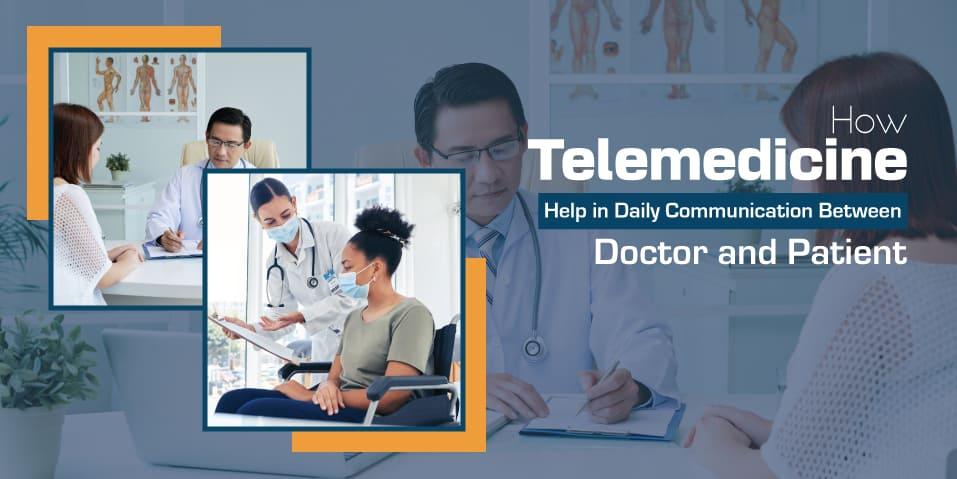How Telemedicine Solutions Help in Communication Between Doctors and Patients
There will soon be issues with our healthcare systems: rapidly rising costs, and difficulty obtaining healthcare coverage in rural areas, can be resolved with the help of telemedicine solutions and a need for more skilled and experienced personnel. On the other hand, the number of chronic diseases is rising, and the population of industrialized nations is getting older, necessitating more care.
So, let’s jot down some crucial details on how Telemedicine solutions to aid in daily negotiations with patients and doctors.
Table of Contents
- Telemedicine Solutions Bridging the Gap Between Patients & Physicians
- Telemedicine Solutions on Daily Conversation Between Patients & Doctors
- Technological Advancements in Telehealth Dealing with Better Communication
- More Ways Telehealth Improving Healthcare Communications
- Conclusion:
Telemedicine Solutions Bridging the Gap Between Patients & Physicians
Hospital administrators, insurance companies, and politicians are looking for solutions to these issues. Technology-based solutions might help make the most of the resources already at your disposal because it takes time and money to train and recruit more employees. Telemedicine, for instance, is regarded as one of the “remedies” for the current circumstance.
Telemedicine is a rapidly expanding market driven by technological advancements, internet coverage, and the proliferation of mobile monitoring devices. As a result, the global telemedicine market, as estimated by Fortune Business Insights, should expand from $billion 49.8 in 2018 to $bn 266.8 in 2026, or a 23.4 percent compound growth rate.
Witnessing these ever-increasing statistics, let’s understand the context more precisely.
Telemedicine Solutions on Daily Conversation Between Patients & Doctors
Telemedicine could tackle the issues made by the absence of government medical care inclusion in rustic regions by offering clinical assistance remotely, for example, for the patient at home.
This includes treating chronic conditions like diabetes. The majority of diagnoses could be made remotely by the doctor. Telemedicine could also be used to a large extent for postoperative care.
Patients who meet the requirements for hospitalization but are otherwise stable can be treated at home, such as for heart conditions or pneumonia, in a virtual hospital “at home.”As a result, treatments will take less time and cost less, freeing up hospital resources for urgent care and necessary on-site treatments.
Technological Advancements in Telehealth Dealing with Better Communication

In the future, “remote” technologies like Augmented Reality (AR) and Virtual Reality (VR) will also assist in utilizing healthcare expertise. This can be helpful in emergencies when dedicated expertise is unavailable in a hospital. It may be accessed through communication with a specialist located in a different location and provides support during surgery.
Surgeons will also be able to visualize the precise positioning of their surgical instruments with the aid of “smart glasses” made of AR content. In addition, telemedicine makes it easier for them to carry out complex medical procedures. During the operation, surgeons can share a patient view, MRI (Magnetic Resonance Imaging), and X-rays with a remote expert in real-time.
When compared to non-AR-supported surgery, this will result in the execution of more skilled and complex surgeries as well as improved accuracy and a decrease in operative errors.
VR has great potential for training and education. For example, it is currently used for surgical simulations and rehabilitation. Without the risk of injuring a patient, students and trainees can learn and practice in a realistic setting.
In addition, patients can be shown their treatment before it begins, giving them a realistic idea of what to anticipate. Even though some of these technologies, like smart glasses, are just starting. They will develop and be used quickly in the coming years.
Are you looking for Telemedicine Solution Development?
More Ways Telehealth Improving Healthcare Communications
Medical practitioners are equipped to treat and see their patients in person. Telehealth can enhance the relationship between a doctor and their patient. Although communicating with patients via live video and audio can be just as effective as meeting in person. Some providers may be uneasy about the idea.
Securing Doctor-Patient Relationships Using Telemedicine Solutions
The most recent telehealth software aims to replicate the in-person experience as closely as possible. As a result, it motivates providers and patients to use these programs. Providers can easily see and talk to patients in real-time with high-definition live video and clear audio. Moreover, as long as both parties have good internet access.
Increasing Access to Healthcare
Telehealth doesn’t entirely decrease face-to-face care, yet it can enhance the specialist-patient relationship in various ways. For example, when approaching this innovation, patients don’t need to stress over driving to and from their nearby specialist’s office. Instead, they can rapidly sign onto their cell phone, tablet, or PC to get their needed data. Patients who fail to show up for their appointments, arrive late, or cancel at the last minute are also less of a concern for doctors.
The relationship between a doctor and a patient can be improved by reducing the distance between them. If it means they don’t have to miss work or drive to the doctor’s office, patients will be more likely to talk to them. Additionally, they will have a better chance of keeping their appointment.
Conclusion:
Telemedicine is undoubtedly elevating healthcare facilities from people with fewer resources to people with enough resources. In addition, it has gained the proper audience traction to boost more virtual healthcare communication rather than in-person meetings. Thanks to vcdoctor telemedicine solutions for expanding this technology on such an incredible landscape.




